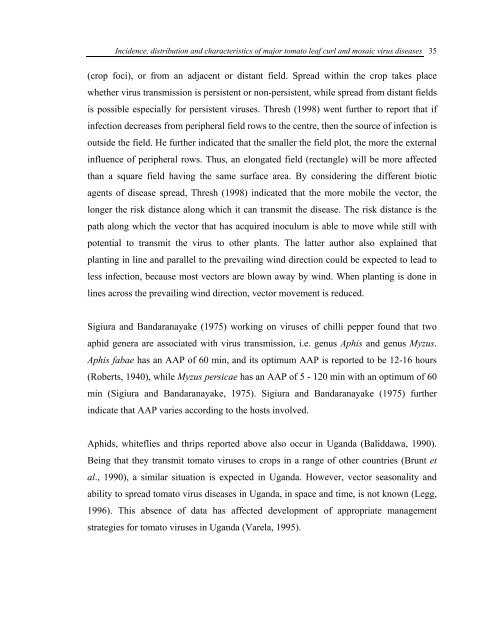Incidence, Distribution and Characteristics of Major Tomato Leaf ...
Incidence, Distribution and Characteristics of Major Tomato Leaf ...
Incidence, Distribution and Characteristics of Major Tomato Leaf ...
Create successful ePaper yourself
Turn your PDF publications into a flip-book with our unique Google optimized e-Paper software.
<strong>Incidence</strong>, distribution <strong>and</strong> characteristics <strong>of</strong> major tomato leaf curl <strong>and</strong> mosaic virus diseases<br />
(crop foci), or from an adjacent or distant field. Spread within the crop takes place<br />
whether virus transmission is persistent or non-persistent, while spread from distant fields<br />
is possible especially for persistent viruses. Thresh (1998) went further to report that if<br />
infection decreases from peripheral field rows to the centre, then the source <strong>of</strong> infection is<br />
outside the field. He further indicated that the smaller the field plot, the more the external<br />
influence <strong>of</strong> peripheral rows. Thus, an elongated field (rectangle) will be more affected<br />
than a square field having the same surface area. By considering the different biotic<br />
agents <strong>of</strong> disease spread, Thresh (1998) indicated that the more mobile the vector, the<br />
longer the risk distance along which it can transmit the disease. The risk distance is the<br />
path along which the vector that has acquired inoculum is able to move while still with<br />
potential to transmit the virus to other plants. The latter author also explained that<br />
planting in line <strong>and</strong> parallel to the prevailing wind direction could be expected to lead to<br />
less infection, because most vectors are blown away by wind. When planting is done in<br />
lines across the prevailing wind direction, vector movement is reduced.<br />
Sigiura <strong>and</strong> B<strong>and</strong>aranayake (1975) working on viruses <strong>of</strong> chilli pepper found that two<br />
aphid genera are associated with virus transmission, i.e. genus Aphis <strong>and</strong> genus Myzus.<br />
Aphis fabae has an AAP <strong>of</strong> 60 min, <strong>and</strong> its optimum AAP is reported to be 12-16 hours<br />
(Roberts, 1940), while Myzus persicae has an AAP <strong>of</strong> 5 - 120 min with an optimum <strong>of</strong> 60<br />
min (Sigiura <strong>and</strong> B<strong>and</strong>aranayake, 1975). Sigiura <strong>and</strong> B<strong>and</strong>aranayake (1975) further<br />
indicate that AAP varies according to the hosts involved.<br />
Aphids, whiteflies <strong>and</strong> thrips reported above also occur in Ug<strong>and</strong>a (Baliddawa, 1990).<br />
Being that they transmit tomato viruses to crops in a range <strong>of</strong> other countries (Brunt et<br />
al., 1990), a similar situation is expected in Ug<strong>and</strong>a. However, vector seasonality <strong>and</strong><br />
ability to spread tomato virus diseases in Ug<strong>and</strong>a, in space <strong>and</strong> time, is not known (Legg,<br />
1996). This absence <strong>of</strong> data has affected development <strong>of</strong> appropriate management<br />
strategies for tomato viruses in Ug<strong>and</strong>a (Varela, 1995).<br />
35





